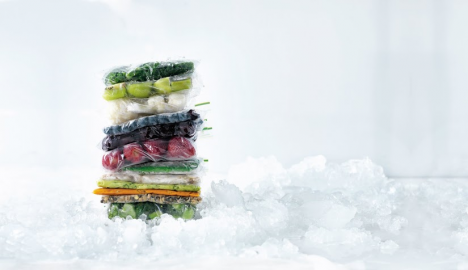So you take some meat out of the freezer and defrost it. You end up using only half of it. What do you do with the rest? Can you put it back in the freezer? Or does it have to be tossed?

If you’re impatient and choose the quicker (but not so safe) method of defrosting in the microwave or under warm water, you’ll need to prepare your food immediately and can only refreeze it after it’s been cooked.
Avoid at all costs: defrosting food on the kitchen bench at room temperature or under hot water. Bacteria multiplies much more rapidly in a warm environment, making these methods simply unsafe.
A stack of freezer hacks:
1. Defrost slowly.
It’s totally fine to refreeze thawed foods (including raw meat, some fish and seafood), provided you’ve defrost it slowly in the first place.
2. Defrost in the fridge.
Always. Not on the bench or sink. Over one or two days.
3. Freeze ‘per serve’ portions.
This way you take only what you need out of the freezer (and don’t even need to worry about refreezing). Plus, single serves defrost quicker.
4. Let things cool down before you freeze them.
This ensures the food will freeze faster. A slow freeze will cause the water cells to expand, which ruptures the food and denatures it.
5. Keep your freezer full.
It’s more energy efficient than an empty one as solids freeze at a lower temperature than air.
6. Separate moist foods.
Spread out berries, cut fruit or par-cooked veggies on a tray and freeze before transferring them into ziplock bags or containers. This reduces clumping.
7. Puree watery foods.
Blend veggies and fruit with a high water content (i.e. tomatoes) before freezing them. You’ll save space in the freezer and you can use them in soups, pasta sauces or smoothies.
8. Always leave a good 2cm free at the top of a container.
Liquid expands when frozen, so this will ensure the container doesn’t crack.
9. Freeze in stackable shapes.
When I freeze things in ziplock bags, I make sure to let all the air out and freeze it flat like a book. This saves space and makes you feel like An Organised Person.
10. Keep the freezer door shut.
When temperatures inside the freezer fluctuated, water molecules leave the foods and lead to what is called ‘freezer burn’ – a white layer of ice. Although it’s absolutely harmless for consumption it can affect taste.
11. Freeze veggies par-cooked.
The process of blanching stops destructive enzymes from altering the quality, colour and vitamins in veggies. This technique, as many of you know, is used extensively on the I Quit Sugar 8-Week Program.
12. Create stock and smoothie bags.
I pop my vegetable and fruit off-cuts (or the daggy-looking kind that have been laying in the fridge for too long) in ziplock bags. I keep adding to them until I have enough to use for stocks or smoothies.
13. Use your ice-cube tray.
These are great for freezing leftover herbs, sauces, pesto, lemon juice, single serve homemade chocolates, egg whites…
14. Make an ice-pack using a ziplock bag.
Stick a wet sponge inside and freeze. And use on sore limbs.
Do you have more hacks to add to the list?

